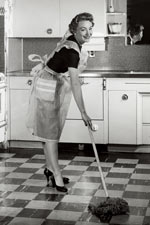Housework: the latest breast cancer preventative?
 Women were told on Friday that they could “substantially” cut their risk for breast cancer by doing ... housework!
Women were told on Friday that they could “substantially” cut their risk for breast cancer by doing ... housework! A study published in the January 2007 issue of the journal Cancer Epidemiology Biomarkers and Prevention reported that of all the types of exercise, housework was associated with the biggest benefit. Dr Lesley Walker, director of cancer information for the charity, Cancer Research
Now before our male counterparts get too excited by this news and use it as reason to leave the cleaning to us, let’s look at what the study actually found.
The researchers culled through a database of questionnaires gathered from 218,169 women at the time of their entry into the European Prospective Investigation into Cancer and Nutrition study during 1992-2000. For this study, they used 3,423 cases of breast cancer reported in breast cancer registries by January 2005. Most (2,554) were post menopausal breast cancers. The highest incidences of breast cancer were among French women, at 2% for premenopausal and 2.7% for postmenopausal breast cancers. The researchers were unable to measure the intensity of various physical activities reported by the women, so they assigned MET values (metabolic equivalents) to each activity. They then looked for correlations between various types and levels of physical activities and the odds of developing breast cancer. Overall, the women who developed breast cancer were older, 53% more likely to use HRT and 11% more likely to be former smokers. (Current smokers were more prevalent among the cancer-free women). In their statistical analysis, the researchers tried to adjust for these and other differences. What did they find? Essentially, nothing. None of the correlations they could come up with were tenable (beyond random chance or statistic error) which the National Cancer Institute in 1994 defined as an increase in relative risk of at least 200 to 300%. Even though the statistics were clinically and practically irrelevant, they may be of interest to readers simply to highlight the extreme discrepancy from the spin being reported. Among the postmenopausal breast cancer risks (measured as odds ratios): Manual labor and heavy occupational work was associated with an 8% higher risk. In total, moderate inactivity was associated with an 11% lower risk. Inactivity proved more protective than being the most active! (Being active was associated with a mere 8% lower risk). Clearly, it is a stretch to conclude that physical activity has much to do with breast cancer! And concerning that “significantly” reduced risk associated with housework: Greater than 42 METs of recreational activity was associated with a whopping 4% lower odds ratio, while comparable levels of housework was associated with a 6% lower risk. So, a woman doing housework could “double” her benefits by being inactive. All of this is splitting hairs with nonsensically minuscule odds ratios when, for this type of cohort study, they simply found no viable correlations between physical activity and breast cancer risks. It is also noteworthy that while the Cancer Research UK’s Reduce the Risk Campaign “recommends maintaining a ‘healthy’ body weight to help prevent cancer,” among the thousands of women from nine countries in this study, there was no difference in body mass index (BMI) among the women who developed breast cancer and those who didn’t
Commentary: The new scientific discovery at the end of that Times article might be of most interest to women looking for a gift for their mates who may hate housework: Dustmates, trendy-looking sports shoes that will vacuum the floor while he walks around the house. :)




<< Home